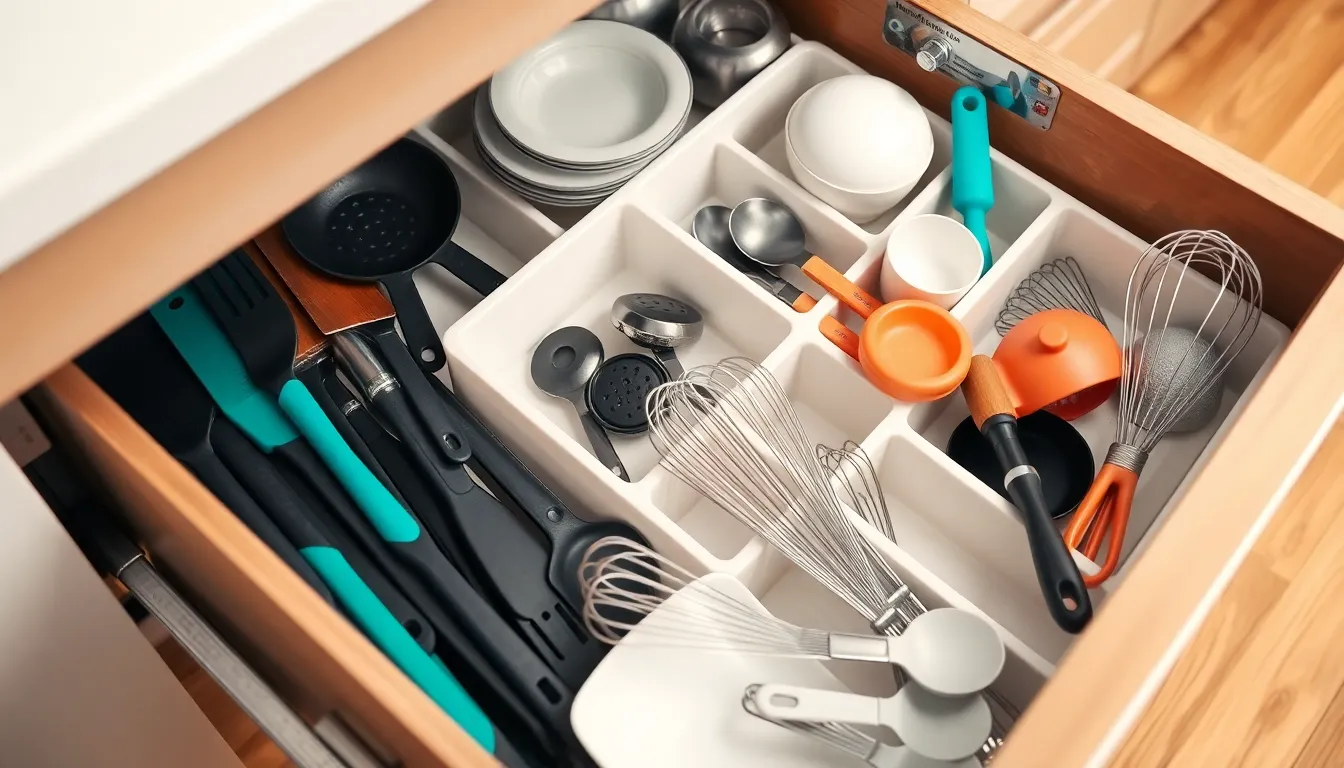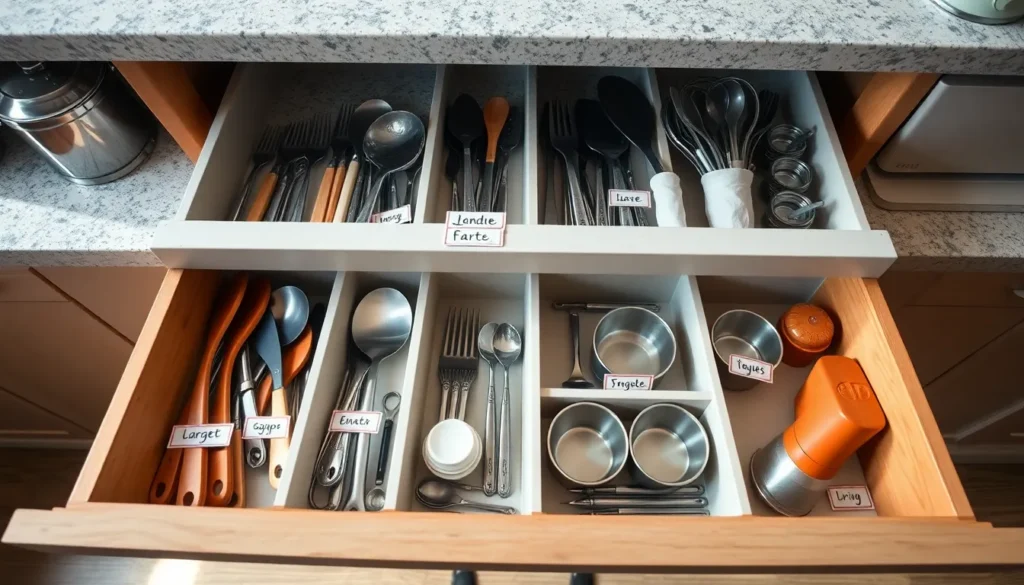A cluttered kitchen drawer can turn meal prep into a frustrating scavenger hunt. With utensils, gadgets, and miscellaneous items jumbled together, finding what you need quickly becomes a challenge. Kitchen drawer organization isn’t just about aesthetics; it’s about creating a functional space that enhances efficiency and makes cooking enjoyable.
By implementing smart organization strategies, anyone can transform chaotic drawers into neatly arranged systems. From using dividers to categorizing items, effective organization techniques can save time and reduce stress in the kitchen. This article explores practical tips and innovative ideas to help anyone tackle their kitchen drawer dilemmas, making every cooking experience smoother and more enjoyable.
Table of Contents
ToggleImportance Of Kitchen Drawer Organization
Effective kitchen drawer organization enhances both functionality and efficiency during meal preparation. A neatly organized drawer minimizes time spent searching for utensils, gadgets, and other cooking essentials. When items are easy to locate, cooking becomes a more enjoyable experience.
Organized drawers prevent clutter, which reduces frustration and distraction. Disorganization may lead to purchasing duplicate items, resulting in wasted money. Utilizing tools such as drawer dividers encourages categorization, providing a clear structure that streamlines access to frequently used items.
Improved kitchen safety results from well-organized drawers. Properly stored sharp utensils and tools prevent accidents and injuries. Clear visibility of contents also reduces the risk of grabbing the wrong item, promoting safer cooking practices.
Additionally, an organized kitchen drawer fosters a sense of control and order. A structured space supports greater creativity and efficiency in cooking, ultimately enhancing culinary skills. The impact of drawer organization extends beyond practicality, improving the overall kitchen experience.
Common Kitchen Drawer Clutter

Kitchen drawers often accumulate clutter that disrupts organization and efficiency. Recognizing the common types of clutter helps in prioritizing the organization process.
Tools And Utensils
Tools and utensils clutter kitchen drawers when stored haphazardly. Spatulas, measuring cups, whisks, and knives often intertwine, leading to chaos. They can vary in size and shape, complicating access. Utilizing drawer dividers allows for organized sections, keeping similar items together. For example, dedicating one section for large utensils like ladles, while another holds small gadgets like peelers, optimizes space. Labeling these sections enhances clarity, making it easy to find necessary items quickly.
Miscellaneous Junk
Miscellaneous junk in kitchen drawers includes items that may no longer serve a purpose, such as rubber bands, outdated takeout menus, and random twist ties. These non-essential items can consume valuable space and create disarray. Identifying and removing these items fosters a cleaner environment. Implementing a routine purging system, such as checking drawers monthly, ensures that unnecessary clutter doesn’t reaccumulate. Using small bins for functional tools, like batteries or extra tape, maintains order and provides easy access to useful, but small, items.
Effective Organization Strategies
Effective organization in kitchen drawers streamlines meal preparation and enhances cooking enjoyment. Implementing specific strategies can significantly improve functionality and accessibility.
Categorizing Items
Categorizing items simplifies organization by grouping similar tools. Shears, spatulas, and ladles belong together, while measuring cups and spoons form another category. By dedicating space for bulky gadgets alongside small utensils, he creates a logical system that facilitates quick access. Labeling each category minimizes confusion, ensuring that every item has its designated spot. This clear structure maintains order and encourages individuals to return items to their appropriate locations after use.
Utilizing Drawer Dividers
Utilizing drawer dividers maximizes available space and separates categories effectively. Adjustable dividers fit various drawer sizes, allowing customization for specific needs. He can use dividers to create compartments for essential items, ensuring that utensils don’t tangle. Regularly assessing divider layouts can optimize storage as the collection of cooking tools expands or changes. Implementing this strategy maintains visual clarity and simplifies locating gadgets, significantly enhancing drawer usability.
Choosing The Right Accessories
Selecting the right accessories enhances kitchen drawer organization and maximizes space effectively. Accessories play a crucial role in maintaining order and simplifying accessibility.
Drawer Organizers
Drawer organizers are essential for creating designated spaces within drawers. They come in various sizes and configurations to accommodate different drawer dimensions and items. Common types include:
- Cutlery trays: Ideal for utensils like forks, knives, and spoons.
- Dividers: Adjustable dividers can be positioned to fit various tools, such as spatulas, whisks, and measuring spoons.
- Stackable bins: Useful for storing gadgets or small items, allowing easy stacking to save horizontal space.
Choosing an organizer based on specific needs ensures that every tool has a place, reducing clutter and enhancing efficiency.
Custom Solutions
Custom solutions offer tailored approaches to kitchen drawer organization. This option caters to unique spaces and specific user preferences. Some common custom solutions include:
- Built-in dividers: These can be installed to match the drawer size and help create compartments for different items.
- Pull-out trays: These solutions enable easy access to deeper drawers, making it simple to retrieve items stored at the back.
- Magnetic strips: These can be mounted inside drawers to hold metal utensils or knives securely, freeing up counter space.
Exploring custom solutions provides flexibility and adaptability to the organization system, ensuring each drawer meets individual cooking needs efficiently.
Maintenance Tips For Long-Term Organization
Regular maintenance ensures the longevity of kitchen drawer organization. Implement these practical tips to maintain a neat and efficient space.
- Establish a Schedule: Set a regular schedule, such as monthly or quarterly, to review drawer contents and reorganize as needed.
- Purge Unwanted Items: Evaluate items regularly. Discard broken utensils or tools rarely used, freeing up space for essentials.
- Rotate Stock: Rotate utensils based on usage frequency. Store frequently used items at the front for easy accessibility.
- Clean the Drawer: Clean drawer surfaces periodically using a damp cloth. Remove food particles and dirt to maintain hygiene.
- Update Labels: Replace or refresh labels as needed. Clear labeling helps identify the contents of each section and reduces confusion.
- Adjust Dividers: Modify dividers based on new tools or changes in kitchen inventory. Flexibility in organization maximizes available space.
- Reassess Categories: Periodically reassess how items are categorized. Adapting organization to changing cooking habits enhances usability.
- Educate Household Members: Share the organization system with others who use the kitchen. Foster adherence to the system for collective maintenance.
- Use Clear Containers: Utilize clear bins or trays for smaller items. Transparency allows for easy visibility and encourages regular checking.
- Keep Instruction Manuals Handy: Store instruction manuals in a designated folder within the drawer. Accessing user guides quickly supports proper tool use and care.
By incorporating these maintenance steps, individuals can preserve organized kitchen drawers, ensuring functionality and enjoyment during cooking.
Transforming kitchen drawers into organized spaces not only enhances efficiency but also elevates the overall cooking experience. By implementing simple strategies like using dividers and categorizing items, anyone can create an orderly environment that fosters creativity and reduces frustration. Regular maintenance and thoughtful organization can prevent clutter from accumulating and ensure that essential tools are always within reach.
Investing time in drawer organization pays off in saved time and improved safety. An organized kitchen drawer system empowers individuals to enjoy cooking more and minimizes the risk of duplicate purchases. Ultimately, a well-organized kitchen contributes to a smoother culinary journey and a more enjoyable atmosphere for all who cook.



